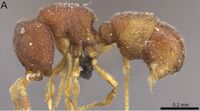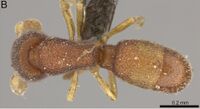Discothyrea hawkesi
| Discothyrea hawkesi | |
|---|---|

| |
| Scientific classification | |
| Kingdom: | Animalia |
| Phylum: | Arthropoda |
| Class: | Insecta |
| Order: | Hymenoptera |
| Family: | Formicidae |
| Subfamily: | Proceratiinae |
| Tribe: | Proceratiini |
| Genus: | Discothyrea |
| Species group: | traegaordhi |
| Species: | D. hawkesi |
| Binomial name | |
| Discothyrea hawkesi Hita-Garcia & Lieberman, 2019 | |
Discothyrea hawkesi is currently known only from the Mkungwe Forest Reserve in Tanzania, where it was collected in primary forest at an elevation of 700 m and apparently lives in leaf litter.
Identification
Hita-Garcia and Lieberman (2019) - The following character combination distinguishes D. hawkesi from the remainder of the complex:
- masticatory margin of mandible edentate
- anterior clypeal margin bearing only few tiny, recurved setae
- anterolateral corner of gena not sharply angled and not denticulate/dentate
- eye absent, or reduced to a tiny pigmented spot
- head distinctly longer than broad
- mesosoma evenly and gently convex in profile
- propodeum conspicuously dentate, declivitous face strongly concave
- mesotibia without apicoventral spur
- AT3 around 1.1 times longer than AT4 (ASI 89–92)
- abdominal sternite 3 not squared in profile
- medial clypeus broad, not clearly projecting
- erect pilosity absent on mesosoma and abdominal terga
Discothyrea hawkesi is a member of a possible natural group within the traegaordhi -complex that includes the species Discothyrea kalypso, Discothyrea maia, Discothyrea michelae, and Discothyrea penthos. These species are united by the presence of differentiated denticles on the propodeum. However, within this assemblage, D. hawkesi lacks the structure of the third abdominal sternite found in the other species.
Keys including this Species
Distribution
Latitudinal Distribution Pattern
Latitudinal Range: -6.89388° to -6.89388°.
| North Temperate |
North Subtropical |
Tropical | South Subtropical |
South Temperate |
- Source: AntMaps
Distribution based on Regional Taxon Lists
Afrotropical Region: United Republic of Tanzania.
Distribution based on AntMaps
Distribution based on AntWeb specimens
Check data from AntWeb
Countries Occupied
| Number of countries occupied by this species based on AntWiki Regional Taxon Lists. In general, fewer countries occupied indicates a narrower range, while more countries indicates a more widespread species. |

|
Estimated Abundance
| Relative abundance based on number of AntMaps records per species (this species within the purple bar). Fewer records (to the left) indicates a less abundant/encountered species while more records (to the right) indicates more abundant/encountered species. |

|
Biology
Castes
 X-ray micro-CT scan 3D model of Discothyrea hawkesi (worker) prepared by the Economo lab at OIST.
X-ray micro-CT scan 3D model of Discothyrea hawkesi (worker) prepared by the Economo lab at OIST.
See on Sketchfab. See list of 3D images.
Nomenclature
The following information is derived from Barry Bolton's Online Catalogue of the Ants of the World.
- hawkesi. Discothyrea hawkesi Hita Garcia & Lieberman, in Hita Garcia, Lieberman, et al. 2019: 48, figs. 4J, 6J-12J, 14J, 37, 38 (w.) TANZANIA.
- Type-material: holotype worker, 1 paratype worker.
- Type-locality: holotype Tanzania: Morogoro, Morogoro, Mkungwe Forest Reserve, -6.89388, 37.90414, 700 m., CEPF-TZ-6.2, 12-15.x.2007, primary forest, leaf litter (P. Hawkes, M. Bhoke & U. Richard); paratype with same data.
- Type-depositories: SAMC (holotype); BMNH (paratype).
- Distribution: Tanzania.
Unless otherwise noted the text for the remainder of this section is reported from the publication that includes the original description.
Description
Worker
(n = 2) EL 0.00; HL 0.46; HW 0.45–0.46; HW 0.36; SL 0.22–0.25; PH 0.22– 0.23; PW 0.27–0.28; DML 0.31–0.32; PrH 0.25–0.27; WL 0.55– 0.58; HFL 0.25; PeL 0.06–0.07; PeW 0.17; PeH 0.17; LT3 0.31–0.32; LT4 0.28; OI 0; CI 78–80; SI 49–54; LMI 49–50; DMI 58–61; DMI2 86–87; ASI 89–92; HFI 54–56; DPeI 283–320; LPeI 243–283.
Head clearly longer than broad, subrectangular (CI 78–80); posterior head margin straight; posterodorsal corners of head rounded; sides of head in frontal view subparallel; eye absent, or reduced to a tiny pigmented spot; frontal lamella rather low in profile, apex gently rounded; with distinct translucent basal fenestra, offset from remainder of disc which is more or less opaque; medial clypeus transverse to gently convex, lateral clypeus curving moderately strongly between antennal sockets and anterolateral corners of head, sides of medial clypeus subparallel laterad antennal sockets, bearing a few tiny, recurved setae. Antennae with relatively shorter scape (49–54), scape strongly incrassate, gently bent; pedicel subglobose, slightly longer than broad; true antennomere count nine; apparent antennomere count eight to ten, flagellomeres basad apical club highly compressed, taken together only about as long as apical club. Ventral head with narrow, weakly sinuate postoccipital ridge without anteromedian carina; medial region of hypostoma rounded-triangular, arms somewhat narrowed, similar in width across their length; palpal formula not examined. Mandible edentate; basal angle broadly rounded, with blunt prebasal angle; ectal face with longitudinal carina running from prebasal angle to apex, confluent with masticatory margin in its distal half, creating a long, comma-shaped depressed region.
Mesosoma evenly and gently convex in profile, pronotum very slightly higher than propodeum; in dorsal view mesosoma moderately thick (DMI 58–61; DMI2 86–87) and narrowed posteriorly, pronotum wider than propodeum; pronotal humeri broadly rounded; posterior propodeal margin very concave between denticles; posterodorsal corners of propodeum denticulate; denticles small but distinct, triangular, laterally flattened and slightly translucent; declivitous face of propodeum clearly concave in profile and oblique posterior view; propodeal spiracle fairly inconspicuous, directed posterolaterally; propodeal lobes well-developed, rounded.
Legs rather short and thin (HFI 54–56); mesotibia without apicoventral spur or seta; mesobasitarsus short, subequal to or shorter than tarsomeres II–IV taken together.
Petiolar node somewhat thick in profile, about 2.4 to 2.8 times higher than long (LPeI 243–283); in profile anterior face of node convex, apex rounded to sloping posteroventrally, posterior face straight; in dorsal view, node roughly subrectangular, about 2.8 to 3.2 times broader than long (DPeI 283–320), sides slightly divergent posteriorly; in anterior view, petiolar outline very broad, roughly hexagonal, dorsal angles more poorly defined than lateral angles; in oblique anterior view, anterior face weakly concave; in ventral view, roughly trapezoidal, sides diverging posteriorly; subpetiolar process broad, lobate to rectangular, apex rounded to truncate; petiolar spiracles relatively small, reniform in ventral view.
Abdominal segment 3 roughly campaniform, widest just anterad end of segment; tergite slightly anteriorly prolonged past anterior margin of AS3; AS3 bulging unevenly, deepest point posterad longitudinal midline in profile, with thick median lobe; prora sinuate; AT3 around 1.1 times longer than AT4 (ASI 89–92); AT4 gently recurved, hemidemispherical; AS4 with quite short but broad anterior lip, overlapping most of the width of AS3, anterior margin straight to weakly convex in ventral view; successive abdominal segments short, telescopic, often concealed.
Sculpture on head densely foveolate, foveolae becoming smaller and denser towards midline of head; mandibles with sparse but distinct piligerous punctae; mesosoma and petiole similarly sculptured to head, becoming punctate-reticulate, mesosoma equally sculptured on dorsum and sides; abdominal segment 3 somewhat sparsely but coarsely punctate, sculpture similar on tergite and sternite; AT4 coriarious-punctate and notably shinier than AT3, sometimes appearing finely granulate or scabriculous due to distribution of punctae.
Setation on head consisting of very fine, inconspicuous appressed pubescence; scape with longer, denser, but still quite fine white appressed pubescence; ectal face of mandible with fairly long, curved, mostly appressed setae; masticatory margin with row of straight setae; mesosomal dorsum, petiolar node, and gastral dorsum with distinct, well-spaced pilosity, appressed to suberect; more standing hairs present on AT3 than other segments; sides of mesosoma and petiole glabrous; sides of gastral terga with some diffuse, fine appressed pubescence; petiolar sternite and abdominal sternite 3 with a few short, erect hairs; abdominal segments five through seven with relatively long, flexuous hairs; legs mostly hairless, with scattered appressed pubescence.
Color testaceous orange, sometimes becoming yellowish in places on gaster; appendages dull yellow.
Type Material
See the beginning of this ("Nomenclature") section for detailed information about the specimen types. A cyber-type of the holotype is also available. This includes: Volumetric raw data (in DICOM format), 3D rotation video, still images of surface volume rendering, and 3D surface (in PLY format) of the physical holotype (South African Museum: CASENT0235470) in addition to stacked digital color images illustrating the head in full-face view, plus profile and dorsal views of the body. The data are deposited at Dryad and can be freely accessed as virtual representations of the type. There is also a Sketchfab 3D surface model of the holotype. It is shown above, in the Caste section, and at Sketchfab (see the link in the Caste Section).
Etymology
The species name is a patronym in honor of our great colleague Peter Hawkes from Pretoria, South Africa, who is likely the most important contemporary collector of Afrotropical ants. He was so kind as to provide invaluable material, without which this revision would not have been possible. The specific epithet is given as a genitive noun.
References
- Hita-Garcia, F., Lieberman, Z., Audisio, T.L., Liu, C., Economo, E.P. 2019. Revision of the highly specialized ant genus Discothyrea (Hymenoptera: Formicidae) in the Afrotropics with x-ray microtomography and 3D cybertaxonomy. Insect Systematics and Diversity 3(6): 5; 1–84 (doi:10.1093/isd/ixz015).
References based on Global Ant Biodiversity Informatics
- Hita-Garcia F., Z. Lieberman, T. L. Audisio, C. Liu, and E. P. Economo. 2019. Revision of the highly specialized ant genus Discothyrea (Hymenoptera: Formicidae) in the Afrotropics with X-ray microtomography and 3D cybertaxonomy. Insect Systematics and Diversity 3(6): 5:1-84.

